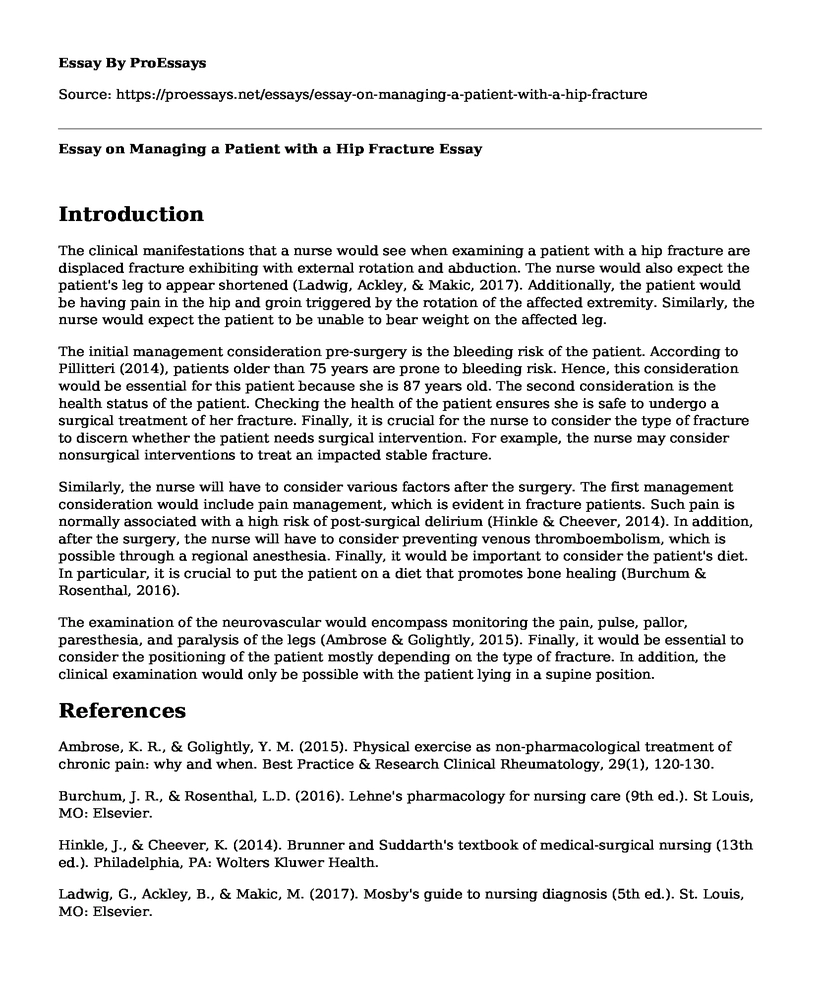Introduction
The clinical manifestations that a nurse would see when examining a patient with a hip fracture are displaced fracture exhibiting with external rotation and abduction. The nurse would also expect the patient's leg to appear shortened (Ladwig, Ackley, & Makic, 2017). Additionally, the patient would be having pain in the hip and groin triggered by the rotation of the affected extremity. Similarly, the nurse would expect the patient to be unable to bear weight on the affected leg.
The initial management consideration pre-surgery is the bleeding risk of the patient. According to Pillitteri (2014), patients older than 75 years are prone to bleeding risk. Hence, this consideration would be essential for this patient because she is 87 years old. The second consideration is the health status of the patient. Checking the health of the patient ensures she is safe to undergo a surgical treatment of her fracture. Finally, it is crucial for the nurse to consider the type of fracture to discern whether the patient needs surgical intervention. For example, the nurse may consider nonsurgical interventions to treat an impacted stable fracture.
Similarly, the nurse will have to consider various factors after the surgery. The first management consideration would include pain management, which is evident in fracture patients. Such pain is normally associated with a high risk of post-surgical delirium (Hinkle & Cheever, 2014). In addition, after the surgery, the nurse will have to consider preventing venous thromboembolism, which is possible through a regional anesthesia. Finally, it would be important to consider the patient's diet. In particular, it is crucial to put the patient on a diet that promotes bone healing (Burchum & Rosenthal, 2016).
The examination of the neurovascular would encompass monitoring the pain, pulse, pallor, paresthesia, and paralysis of the legs (Ambrose & Golightly, 2015). Finally, it would be essential to consider the positioning of the patient mostly depending on the type of fracture. In addition, the clinical examination would only be possible with the patient lying in a supine position.
References
Ambrose, K. R., & Golightly, Y. M. (2015). Physical exercise as non-pharmacological treatment of chronic pain: why and when. Best Practice & Research Clinical Rheumatology, 29(1), 120-130.
Burchum, J. R., & Rosenthal, L.D. (2016). Lehne's pharmacology for nursing care (9th ed.). St Louis, MO: Elsevier.
Hinkle, J., & Cheever, K. (2014). Brunner and Suddarth's textbook of medical-surgical nursing (13th ed.). Philadelphia, PA: Wolters Kluwer Health.
Ladwig, G., Ackley, B., & Makic, M. (2017). Mosby's guide to nursing diagnosis (5th ed.). St. Louis, MO: Elsevier.
Pillitteri, A. (2014). Maternal and child health nursing: Care of the childbearing and childrearing family (7th ed.). Philadelphia, PA: Lippincott Williams & Wilkins.
Cite this page
Essay on Managing a Patient with a Hip Fracture. (2022, Jun 19). Retrieved from https://proessays.net/essays/essay-on-managing-a-patient-with-a-hip-fracture
If you are the original author of this essay and no longer wish to have it published on the ProEssays website, please click below to request its removal:
- Evidence-Based Management
- Impact of the Artful Moments Intervention on Persons With Dementia and Their Care Partners
- Institutional Affiliated: Kuwait Healthcare
- Essay Sample on Learning Disability of America
- Psychological and Social Aspects of Health Education Essay Example
- Uncovering Community Problems: A Guide to Identification & Solutions - Essay Sample
- EHR System: Administrative Processes & Benefits - Essay Sample







